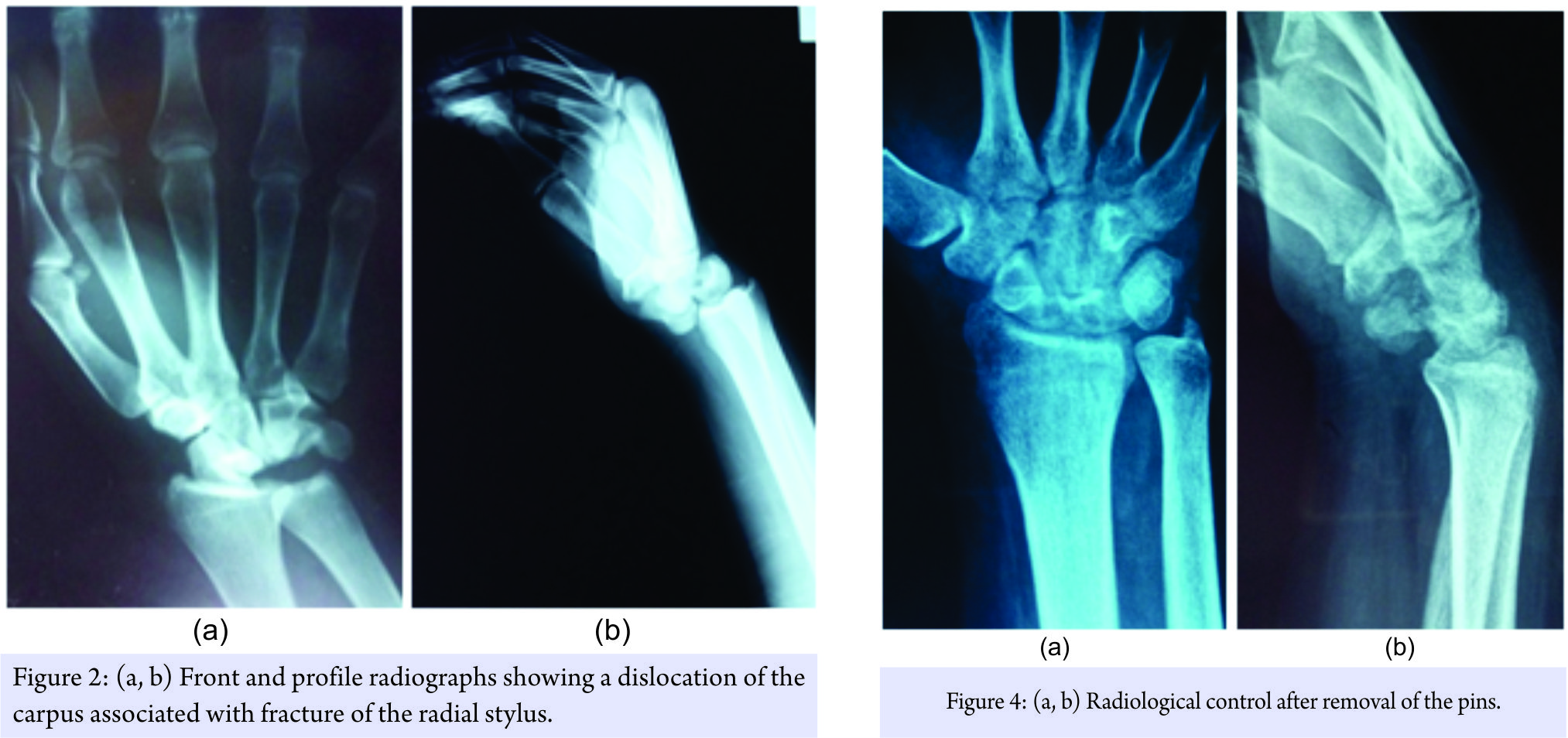[box type=”bio”] Learning Points for this Article: [/box]
Open anterior peri-lunar dislocation of the carp, in view of their rarity, represent a pitfall in traumatology which can be avoided by means of careful x-ray examination.
Case Report | Volume 7 | Issue 5 | JOCR Sep – Oct 2017 | Page 38-41| Hassini Lassaad, Nawar Nader, Youcef Othmen, Mtaoumi Mourad, Mohamed Laziz Ben Ayeche. DOI: 10.13107/jocr.2250-0685.888
Authors: Hassini Lassaad [1], Nawar Nader [1], Youcef Othmen [1], Mtaoumi Mourad [1], Mohamed Laziz Ben Ayeche [1]
[1] Department of Orthopedic, Sahloul Hospital, Sousse, Tunisia.
Address of correspondence
Dr. Hassini Lassaad,
Department of Orthopedic Surgery, Sahloul Hospital 4054,Sousse, Tunisia.
E-mail: lassaadhassini@hotmail.fr
Abstract
Introduction: The anterior perilunate dislocations of the carp (PDC)are exceptional and poorly known lesions, which may go unnoticed in an emergency. They derive their importance from the severity of sequelae, which are dominated by chronic wrist instability and long-term osteoarthritis.
Case Report: We report the case of an open anterior PDC with no carpal fracture in a young patient. The injury occurred in a road accident and was treated at once with satisfactory results 1year after.
Conclusion: The management of carp dislocations is not well codified in the literature. Surgical treatment is often necessary to restore intracarpal anatomy. The prognosis is often good if diagnosed early.
Keywords: Anterior, Perilunate, Dislocation, Carp.
Introduction
Osteo-ligamentous carpal lesions are often the result of a violent trauma in young males. Perilunardislocation of the carp is the most common and best known of carpal dislocations; it may causesevere functional sequelae. The anterior dislocation is exceptional and represents only in 3-6% of perilunate dislocations of the carp (PDC) [1,2,3]. We report a single case of an open anterior PDC in a 25-year-old patient who underwent urgent surgical treatment with a good functional result at 1yearfollow-up.
Case Report
A 25-year-old right-handedmalemechanic with no medical history presents with an open left wrist trauma as a result of a motorcycle fall with reception on his left wrist in hyperflexion. The initial clinical examination revealed a left wrist “back of fork” deformity with an anterior cutaneous 5cmlong wound with contused edges (Fig. 1a, b). The radialpulse was present. No nerve deficiency was found. Plain radiographs of the left wrist showed an anterior PDC associated with a fracture of the radial styloid with no fracture in the carpal bones (Fig. 2a, b). Front view showeda rupture of the line passing through the radial styloid and the scapho-lunar ligament. Side view confirmed the anteriordis placement of the carp bones regarding the lunatumattesting theanteriorvariety of this PDC. The lunatum remained strictly under the radial advent with its anterior and posterior attaches to the distal radius epiphysis intact.
The patient was taken to the operating room at once and underwent a reduction under loco-regionalanesthesia;the wound was trimmed and cleaned. No vascular, nerve or tendon lesion was found. After reduction, scapho-lunarstabilization was obtained using a K-wirefixation. A second K-wire was put through radiolunar and lunocapital joints(Fig. 3a, b).Additional stabilization was provided by abelow-the-elbow castfor6weeks. After the same period, K-wires removal was made (Fig. 4a, b). Physical therapy sessions were then started.
After a follow-up of 1 year, the clinical result was satisfactory (Fig. 5a, b), evaluated on pain, mobility, gripping force, and function. His left wrist was strictly painless. Wrist range of motion was as following: Palmar flexion was 80°, dorsal flexion at 70°, 15° of radial tilt, and 20° of ulnar tilt. The gripping strength of the wrist was judged normal comparedto the healthy side. Plain radiographs showed healing of the radial styloid fracture with no signs of intracarpal instability, osteoarthritis, or osteonecrosis of carpal bones.
Discussion
PD Care rare. They represent about 5% of the wrist injuries [4] and generally occur in young adults following violent trauma. In such context, the dislocation could be overlooked in front of life-threatening injuries. They are defined as a total loss of contact between the capitatum and the lunatum. Several varieties have been reported regarding the path by the dislocation line, the direction of displacement and the associated fractures. The anteriorvarietyis exceptional compared to the dorsal one. It counts for3-6%of all PDC [1, 2, 3]. This variety was reported for the first time by Speed in 1925 [5]. The first illustrated observation studying the mechanism and treatment was made by Aitken and Nalebuff in 1960 [5]. There is often an associated fracture either in the scaphoid, the trapezium, anterior horn of the lunatumand/or the hamatum [6]. To the best of our knowledge, none of the so far reported cases was open. The usual injury mechanism of the anterior PDC is a high energy traumatism with an impact on the hand, the wrist being in palmar hyperflexion so that the capitatum pushes the lunatum [1, 5]. They are often of Type I according to the classification of Witvoet and Allieu with conservation of the anterior and posterior brakes [7]. The clinical examination of the wrist is of poor contribution. There is anterior and posterior edema, sometimes an anterior hematoma, pain on palpation, and mobilization of the wrist. Paresthesia in the median nerve area and difficulties in the flexion and extension of the fingers may be found, suggesting a median nerve irritation. The cutaneous opening is exceptional. The diagnosis is radiological. The side view asserts dislocation, showing a loss of contact between the capitatum and the lunatum, and permits the classification of perilunary dislocations according to the classification of Witvoet and Allieu. On the front view, the pathognomonic sign is the disappearance of the inter line and the overlap between the lunatum and the capitatum. The treatment is controversial. Most are currently advocating surgical treatment for dislocations associated with a fracture and for isolated dislocation if closed reduction fails [1]. The open reduction allows for some to get an anatomical reduction. Some believe that more systematic ligament suture could promote better ligament healing and prevents long-term intracarpal instability [8]. The choice of the surgical approach depends on the type of dislocation. The posterior approach is easier in case of isolated dislocation. In the transscaphoantelunar dislocations, the anterior approach allows a better osteosynthesis of the scaphoid [9]. When PDC is diagnosedin a late stage, reduction becomes difficult to obtain, and the direct repair of ligamentous disruption becomes impossible. In such situation, open reduction is the only option and it involves a preliminary release of carpal bones from the fibrous scar tissue formed by time. This liberation although necessary could harm vascularization of bones. As regards of the ligamentous lesions, the only option is ligamentoplasty to treat the remaining wrist instability. This treatment involves the scapho-lunarligament, and multiple techniques are used, including capsular, tendon, and ligamentous techniques. The anatomical results of these techniques are good, but the results in terms of pain control, mobility, and force are not optimal regardless of the technique[10]. Anterior PDC may leave severe functional sequelae. Most often, it involves carpal instability, stiffness, decreased strength, and pain [9]. Most of the published cases in the literature do not indicate a necrosis of the lunatum as it often remains in its normal position under the radial advent. No necrosis of the scaphoid was reported either [9].
Conclusion
The case we report is unique because of the lack of associated carpal fracture and the skin opening. It is important to make the diagnosis at the stage of fresh lesion to undertake the right treatment quickly and then reduce the risk of bad functional result. The modalities and indications of this treatment remain controversial and large studies are not possible because of the low incidence of the lesion.
Clinical Message
Despite its scarcity, anterior perilunar dislocations of the carp have to be known by every trauma practitionerregarding sequelaeit may generate.
References
1. Ouarab M, Fnini S, Harfaoui A, Trafeh M. Les luxations antélunaires du carpe. À propos de troiscas. Ann Chir Main 2000;19:235-242.
2. Ragois PH, Kadji O, Leclerc R. Luxation trans-scapholunaire antérieure du carpe. À propos d’un cas. Ann Chir Main 1999;18(4):304-308.
3. Vichard P, Tropet Y, Balmat P, Brientini JM, Pem R. Réflexions à propos de quatre observations de luxations antélunaires du carpe. Ann Chir Main 1991;10:331-336.
4. Cooney WP, Bussey R, Dobyns JH, Linscheid RL. Difficult wrist fractures. Perilunate fracture-dislocations of the wrist. Clin Orthop Relat Res 1987;214:136-147.
5. Aitken AP, Nalebuff EA. Volar transnavicularperilunar dislocation of the carpus. J Bone Joint Surg Am 1960;42-A:1051-1057.
6. Wodecki PH, Guigui P, Masmejean E. Luxation trans-scaphocapitale du carpe: Une nouvelle varieté, une nouvelle approche. Ann Chir Main 2002;21:143-147.
7. Witvoet J, Allieu Y. Lésions traumatiques fraîches du semilunaire. Rev Chir Orthop 1973;59 Suppl 1:98-125.
8. Bellot F, Tran Van F, Leroy N, Blejwas D, Mertl P. [Peri-lunate wrist dislocation: Long-term outcome]. Rev Chir Orthop Reparatrice Appar Mot 2003;89(4):320-332.
9. Amar MF, Loudyi D, Chbani B, Bennani A, Boutayeb F. Luxation trans-scapholunaire antérieure du carpe. À propos d’un cas. Ann Chir Main 2009;28(6):374-377.
10. Chabas JF, Gay A, Valenti D, Guinard D, Legre R. Results of the modified Brunelli tenodesis for treatment of scapholunate instability: A retrospective study of 19 patients. J Hand Surg Am 2008;33(9):1469-1477.
 |
 |
 |
 |
 |
| Dr. Hassini Lassaad | Dr. Nawar Nader | Dr. Youcef Othmen | Dr. Mtaoumi Mourad | Dr. Mohamed Laziz Ben Ayeche |
| How to Cite This Article: Hassini L, Nawar N, Othmen Y,Mtaoumi M, Ben Ayeche ML. Open Anterior Peri-lunar Dislocation of the Carp: A Case Report. Journal of Orthopaedic Case Reports 2017 Sep-Oct;7(5):34-37. |
[Full Text HTML] [Full Text PDF] [XML]
[rate_this_page]
Dear Reader, We are very excited about New Features in JOCR. Please do let us know what you think by Clicking on the Sliding “Feedback Form” button on the <<< left of the page or sending a mail to us at editor.jocr@gmail.com







